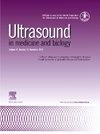Ultrasound Shear Wave Elastography and Shear Wave Dispersion: Correlation with Histopathological Changes in Autoimmune Hepatitis Patients
IF 2.4
3区 医学
Q2 ACOUSTICS
引用次数: 0
Abstract
Objective
To evaluate the correlation between liver viscosity, as measured by shear wave dispersion (SWD), and fibrosis and inflammation in patients with autoimmune hepatitis (AIH). Additionally, to assess its potential as a non-invasive biomarker for hepatic fibrosis compared to shear wave elastography (SWE).
Methods
This prospective study included 25 AIH patients who underwent pre-biopsy SWD and SWE measurements using the SuperSonic Mach30 system. Liver biopsy samples were assessed for fibrosis using the Scheuer grading system and for inflammation using the modified Hepatic Activity Index (mHAI). Correlations between viscosity, elastography, fibrosis, and inflammation were analysed using Spearman's correlation coefficients.
Results
Viscosity demonstrated a significant correlation with fibrosis stages (Spearman's coefficient: 0.58, p = 0.002), while SWE showed a weaker correlation (Spearman's coefficient: 0.50, p = 0.01). Viscosity measurements also correlated moderately with the mHAI score (Spearman's coefficient: 0.62, p = 0.001). Subgroup analyses revealed weak to moderate correlations between viscosity and mHAI components across fibrosis stages.
Conclusion
Our study suggests that viscosity may be better than SWE as a non-invasive marker for assessing hepatic fibrosis in AIH, particularly in the pre-treatment period when inflammation levels are elevated. However, we could not conclusively determine the relationship between viscosity and hepatic inflammation, as a small sample size limited our findings. Further research with a larger cohort of AIH patients is necessary to better understand the correlation between viscosity and inflammation in this rare condition.
超声剪切波弹性成像和剪切波色散:与自身免疫性肝炎患者组织病理学改变的相关性。
目的:探讨自身免疫性肝炎(AIH)患者肝脏剪切波弥散度(SWD)测定的肝黏度与纤维化和炎症的相关性。此外,与剪切波弹性成像(SWE)相比,评估其作为肝纤维化非侵入性生物标志物的潜力。方法:这项前瞻性研究包括25例AIH患者,他们接受活检前SWD和超声Mach30系统测量SWE。肝活检样本使用Scheuer分级系统评估纤维化,使用改良的肝活动指数(mHAI)评估炎症。使用Spearman相关系数分析粘度、弹性成像、纤维化和炎症之间的相关性。结果:黏度与纤维化分期有显著相关性(Spearman系数:0.58,p = 0.002), SWE相关性较弱(Spearman系数:0.50,p = 0.01)。粘度测量值也与mHAI评分适度相关(Spearman系数:0.62,p = 0.001)。亚组分析显示,黏度和mHAI成分在纤维化分期之间存在弱至中度相关性。结论:我们的研究表明,粘度可能比SWE作为评估AIH肝纤维化的非侵入性标志物更好,特别是在治疗前炎症水平升高的时期。然而,由于样本量小限制了我们的研究结果,我们不能最终确定粘度和肝脏炎症之间的关系。为了更好地了解这种罕见疾病的黏度与炎症之间的关系,有必要对更大的AIH患者进行进一步的研究。
本文章由计算机程序翻译,如有差异,请以英文原文为准。
求助全文
约1分钟内获得全文
求助全文
来源期刊
CiteScore
6.20
自引率
6.90%
发文量
325
审稿时长
70 days
期刊介绍:
Ultrasound in Medicine and Biology is the official journal of the World Federation for Ultrasound in Medicine and Biology. The journal publishes original contributions that demonstrate a novel application of an existing ultrasound technology in clinical diagnostic, interventional and therapeutic applications, new and improved clinical techniques, the physics, engineering and technology of ultrasound in medicine and biology, and the interactions between ultrasound and biological systems, including bioeffects. Papers that simply utilize standard diagnostic ultrasound as a measuring tool will be considered out of scope. Extended critical reviews of subjects of contemporary interest in the field are also published, in addition to occasional editorial articles, clinical and technical notes, book reviews, letters to the editor and a calendar of forthcoming meetings. It is the aim of the journal fully to meet the information and publication requirements of the clinicians, scientists, engineers and other professionals who constitute the biomedical ultrasonic community.

 求助内容:
求助内容: 应助结果提醒方式:
应助结果提醒方式:


